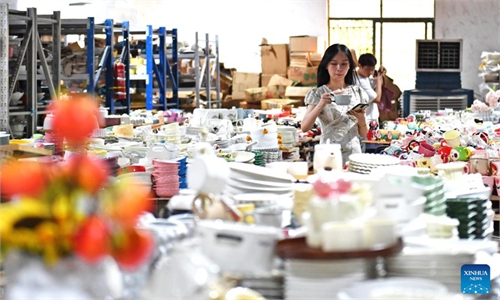China prepares for year-end shopping rush with fresh round of consumer vouchers
Measures drive economic revival with notable multiplier effect: analyst

This photo taken by Catherine Gulua, an attendee of the sixth World Media Summit, shows the interior view of a shopping mall in Urumqi, northwest China's Xinjiang Uygur Autonomous Region, Oct. 13, 2024. (Photo: Xinhua)
As the year-end shopping season approaches, cities in China have rolled out new rounds of consumption vouchers tailored to local needs, regional characteristics and consumer preferences, to boost market activity and support the recovery of consumption.The new round of consumption vouchers covers a wide range of sectors. Shanghai launched a variety of vouchers on Saturday, targeting areas such as catering, accommodation, movies, and sports, with offers like 90 yuan ($12) off when spending 300 yuan or 180 yuan off when spending 600 yuan.
Beijing recently announced the further distribution of more than 30,000 ice and snow consumption vouchers to promote sports and boost the winter sports market.
In places like Southwest China's Sichuan Province and Central China's Hubei Province, they focus on sectors such as home furnishings, automobiles and digital products, combining consumer promotion with improving people's livelihoods to drive both growth and quality in consumption.
On September 26, the Political Bureau of Communist Party of China Central Committee held a meeting and stressed that it is imperative to integrate efforts to boost consumption and improve people's well-being, enable low- and middle-income groups to earn more and optimize the consumption structure, according to the Xinhua News Agency.
New forms of business for consumption should be cultivated, the meeting noted.
The Ministry of Commerce, together with the local governments of Shanghai, Beijing, Guangzhou, Tianjin and Chongqing - the five international consumption hub cities—hosted a Consumption Month event in November.
This Consumption Month is a centerpiece of the 2024 Year of Consumer Promotion. The five cities will issue vouchers for dining, culture, tourism and sports. These initiatives, combined with the activities of Consumption Month, aim to amplify their effect and provide real benefits to consumers, Vice Minister of Commerce Sheng Qiuping said at a press conference on November 1.
In the first 10 months of the year, China's total retail sales of consumer goods recorded 39.896 trillion yuan, up 3.5 percent year-on-year, data from the National Bureau of Statistics shows.
Online retail sales totaled 12.36 trillion yuan, up 8.8 percent year-on-year.
Consumption vouchers help increase residents' purchasing power and willingness to spend, creating a multiplier effect that stimulates the consumer market and accelerates economic recovery, Zhou Maohua, an economist at China Everbright Bank, told the Global Times on Monday.
Their effect is especially noticeable for low- and middle-income groups, improving their sense of well-being. By boosting sales for businesses and encouraging investment, the vouchers also help create jobs and raise incomes for residents, Zhou noted.
Linfen, a city in North China's Shanxi Province, issued a total of 290 million yuan in consumption vouchers over the past four years, driving 2.7 billion yuan in consumer spending, according to local newspaper Shanxi Economic Daily.
Since October, Central China's Henan Province has distributed 200 million yuan in "Golden Autumn" consumption vouchers in four rounds, generating 631 million yuan in direct consumer spending, data from the local government showed.
A series of incremental policies are helping shift China's economic growth model from being driven by trade and investment to being driven by domestic demand and consumption, Shan Hui, Goldman Sachs' chief China economist, told media on Wednesday.
Goldman Sachs predicted that consumption growth in the market could recover from 3.8 percent in 2024 to 5 percent in 2025. This is mainly due to more targeted fiscal spending and subsidies in consumer-focused sectors, among others, Shan said.


